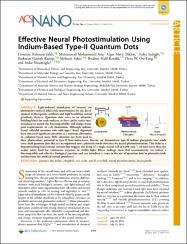| dc.contributor.author | Jalali, Houman Bahmani | |
| dc.contributor.author | Aria, Mohammad Mohammadi | |
| dc.contributor.author | Dikbas, Ugur Meric | |
| dc.contributor.author | Sadeghi, Sadra | |
| dc.contributor.author | Kumar, Baskaran Ganesh | |
| dc.contributor.author | Sahin, Mehmet | |
| dc.contributor.author | Kavakli, Ibrahim Halil | |
| dc.contributor.author | Ow-Yang, Cleva W. | |
| dc.contributor.author | Nizamoglu, Sedat | |
| dc.date.accessioned | 2019-07-04T07:32:20Z | |
| dc.date.available | 2019-07-04T07:32:20Z | |
| dc.date.issued | 2018 | en_US |
| dc.identifier.citation | ACS NANO Volume: 12 Issue: 8 Pages: 8104-8114 DOI: 10.1021/acsnano.8b02976 | en_US |
| dc.identifier.issn | 1936-0851 | |
| dc.identifier.issn | eISSN: 1936-086X | |
| dc.identifier.other | PubMed ID: 30020770 | |
| dc.identifier.other | Accession Number: WOS:000443525600061 | |
| dc.identifier.other | DOI: 10.1021/acsnano.8b02976 | |
| dc.identifier.uri | http://acikerisim.agu.edu.tr/xmlui/handle/20.500.12573/63 | |
| dc.description | This project has received funding from the European Research Council (ERC) under the European Union's Horizon 2020 Research and Innovation Programme (grant agreement no. 639846). We thank KUYTAM (Koc University Surface Science and Technology Center) for providing XRD and UV-vis-NIR spectrophotometer infrastructures. We also thank Dr. Ceren Yilmaz Akkaya for XRD and Prof. Havva Funda Acar Yagci for the PL measurement. | en_US |
| dc.description.abstract | Light-induced stimulation of neurons via photoactive surfaces offers rich opportunities for the development of therapeutic methods and high-resolution retinal prosthetic devices. Quantum dots serve as an attractive building block for such surfaces, as they can be easily functionalized to match the biocompatibility and charge transport requirements of cell stimulation. Although indium based colloidal quantum dots with type-I band alignment have attracted significant attention as a nontoxic alternative to cadmium-based ones, little attention has been paid to their photovoltaic potential as type-II heterostructures. Herein, we demonstrate type-II indium phosphide/zinc oxide core/shell quantum dots that are incorporated into a photoelectrode structure for neural photostimulation. This induces a hyperpolarizing bioelectrical current that triggers the firing of a single neural cell at 4 mu W mm(-2), 26-fold lower than the ocular safety limit for continuous exposure to visible light. These findings show that nanomaterials can induce a biocompatible and effective biological junction and can introduce a route in the use of quantum dots in photoelectrode architectures for artificial retinal prostheses. | en_US |
| dc.description.sponsorship | European Research Council (ERC) under the European Union's Horizon 2020 Research and Innovation Programme - 639846 | en_US |
| dc.language.iso | eng | en_US |
| dc.publisher | AMER CHEMICAL SOC, 1155 16TH ST, NW, WASHINGTON, DC 20036 USA | en_US |
| dc.relation.ispartofseries | ACS NANO;Volume: 12 Issue: 8 Pages: 8104-8114 | |
| dc.rights | info:eu-repo/semantics/openAccess | en_US |
| dc.subject | quantum dot | en_US |
| dc.subject | indium phosphide | en_US |
| dc.subject | zinc oxide | en_US |
| dc.subject | type-II core/shell | en_US |
| dc.subject | neural | en_US |
| dc.subject | photostimulation | en_US |
| dc.subject | biocompatible | en_US |
| dc.title | Effective Neural Photostimulation Using Indium-Based Type-II Quantum Dots | en_US |
| dc.type | article | en_US |
| dc.contributor.department | AGÜ, Mühendislik Fakültesi, Malzeme Bilimi ve Nanoteknoloji Mühendisliği Bölümü | en_US |
| dc.contributor.institutionauthor | | |
| dc.relation.publicationcategory | Makale - Uluslararası Hakemli Dergi - Kurum Öğretim Elemanı | en_US |


















